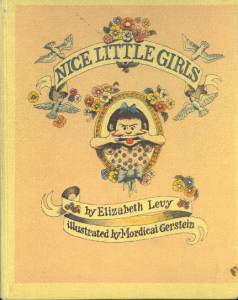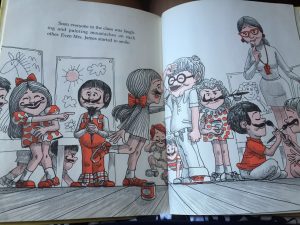Author: Elizabeth Levy
Illustrator: Mordicai Gerstein
Publishing Information: Delacorte Pr 1974.
Number of Pages: 46
Genre: Non-fiction, Picture book


Analysis:
Jackie is a different little girl. Everyone in her class calls her a boy. She does not wear dresses as other girls in her class do. She wants to build a box. However, her teacher Mrs. James always wants Jackie to be a nice little girl. Suggested by her parents, Jackie decides to be herself. Finally, her classmates realize that Jackie is actually brave. At the party, they paint moustaches on each other’s faces.
The text functions as a mirror for children to have a reflection on their own school life. Readers of different ages may have different takeaways from the story. For children, they might ask themselves if they are in a similar situation as Jackie is or if there is any student like Jackie in their class and how they have treated him or her. For parents, they might reconsider the way they communicate with their children. When teachers call and tell them about the problems of their children, do they just take what the teachers say and blame the children right away or do they do the same thing as Jackie’s parents did, “hear the children’s side of the story” (p. 20).
While gender stereotypes and gender discriminations do not exist in the text, race discrimination is presented. In the book, all characters from the teacher to all of the students are illustrated as white people. Children might get the wrong impression about school. Diversity should be stressed in children’s literature, especially in those with the theme of school life like this one.
Perceptually, the illustrator use pencil sketch to draw the pictures. Such delicate illustrations can definitely attract readers. The images are not framed which help readers to put themselves in the plot development. Structurally, text and images do not overlap which give readers a clearer view of the story. Ideologically, the book teaches children that there is no such thing as a “girl’s job” or a “boy’s job”? They can pursue any kinds of hobby as long as they enjoy them. Secondly, the story also shows children that teachers are not always right. It is important to communicate with parents. Thirdly, the book tells children that if some students in your class seem different than others, do not judge them and if you get to know them personally, they might be very nice people.
